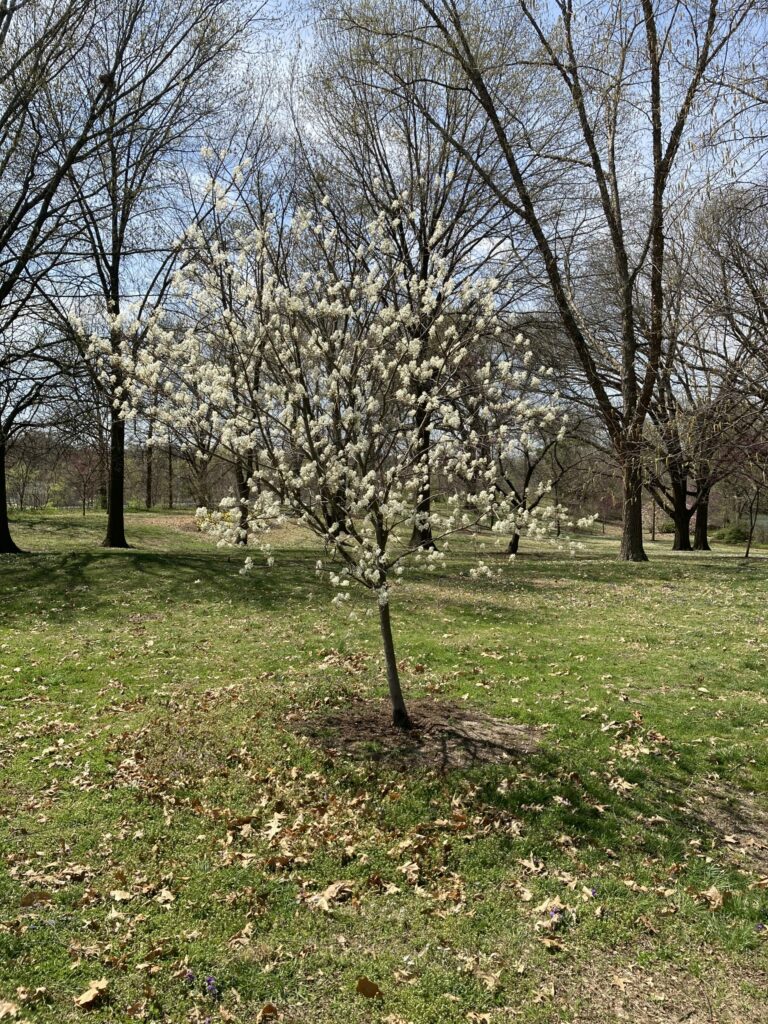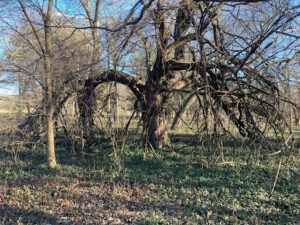Serviceberry (Amelanchier spp., in our region typically A. canadensis, A. arborea and A. x grandiflora) has easily climbed its way to the top of nearly every list you’ll see of recommended small native trees or shrubs. Although it can reach 60 feet tall in optimal growing conditions in the wilds of the Appalachians, around here 20 feet would be a huge serviceberry, making it an ideal plant for small lawns, planting under power lines, or other areas where size is limited. One of the great contenders in the “is it a tree or shrub” debate, serviceberry can be found in both forms, as a single-trunked, low branching tree or a multi-stemmed shrub. Although its growth rate is only moderate and it can be susceptible to transplant shock, serviceberry is quite adaptable to a variety of soil conditions and can grow in full sun or even quite heavy shade. Just make sure the soil has decent drainage and give it a nice wide mulch ring.
This versatility in culture and habit is only the tip of the iceberg when it comes to the desirable features of these plants. Their snow-white flowers are usually one of the first of spring, signalling the coming of pleasant weather. The foliage is reliably free from pests (unusual given its presence in the Rosaceae family – its relatives are famously disease magnets) making it attractive in the summer. When their chlorophyll drains in the fall, the leaves’ remaining carotenoid pigments create a lovely pumpkin-orange color. In winter the smooth, grey bark and elegant branching habit are on display, making it truly a plant for all seasons.
Of course the best thing about serviceberries is the berries! Similar in shape, size and flavor to blueberries, they ripen in late May or early June (in Canada serviceberries are often called “juneberry” or by their Cree name “saskatoon”. A. alnifolia is prolific enough in Canada that its berries are a commercial crop and the city of Saskatoon, Saskatchewan takes its name from them).The deliciousness of these berries is accentuated by the small seed in their center, which tastes similar to an almond. It’s worth spending a few hours to pick enough of these treats to make a pie, a pan of muffins, or a pancake feast. (I even have a bottle of homemade serviceberry liqueur to periodically remind me of that heavenly time when they ripen, as the days grow warmer and spring turns lazily to summer…)
No discussion of serviceberry would be complete without a foray into the etymology of the common name, which is usually given as follows: “The bloom time of serviceberry is an indicator that the ground will soon be thawed, and the dead bodies that have accumulated over the winter can be buried (a “service” can be held).” This is what is known as “folk etymology”, a fancy way of saying “made up nonsense”. The older form of the name is “sarvis”, not “service”, and comes from the fruit’s slight resemblance to that of the Sorbus genus of Europe, which was spelled and pronounced “sarvis” in the colonial era. It’s a less interesting explanation (folk etymology is always more entertaining) but also less morbid. (I prefer to call them saskatoons, partly to honor the Native American heritage of our land and partly because I just prefer the way it sounds. But a saskatoon by any other name would taste just as sweet and almond-y).
Plant an Amelanchier in your yard. You have room. Just be quick on the draw if you want berries – otherwise the birds will pick the tree clean before you get your share!




